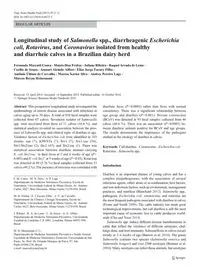
2015 Longitudinal study ofSalmonellaspp_, diarrheagenicEscherichia coli,Rotavirus, andCoronavirusisolated from healthy a PDF
Preview 2015 Longitudinal study ofSalmonellaspp_, diarrheagenicEscherichia coli,Rotavirus, andCoronavirusisolated from healthy a
REGULAR ARTICLES Longitudinal study of Salmonella spp., diarrheagenic Escherichia coli, Rotavirus, and Coronavirus isolated from healthy and diarrheic calves in a Brazilian dairy herd Fernanda Morcatti Coura & Moisés Dias Freitas & Juliane Ribeiro & Raquel Arruda de Leme & Cecília de Souza & Amauri Alcindo Alfieri & Elias Jorge Facury Filho & Antônio Último de Carvalho & Marcos Xavier Silva & Andrey Pereira Lage & Marcos Bryan Heinemann Received: 15 April 2014 /Accepted: 16 September 2014 /Published online: 14 October 2014 # Springer Science+Business Media Dordrecht 2014 Abstract This prospective longitudinal study investigated the epidemiology of enteric disease associated with infections in calves aging up to 70 days. A total of 850 fecal samples were collected from 67 calves. Seventeen isolates of Salmonella spp. were recovered from feces of 11 calves (16.4 %), and statistical analysis revealed no association between the pres- ence of Salmonella spp. and clinical signs of diarrhea or age. Virulence factors of Escherichia coli were identified in 103 strains: eae (7), K99/STa (7), Stx1 (7), Stx1/eae (36), Stx1/Stx2/eae (2), Stx2 (43), and Stx2/eae (1). There was statistical association between diarrheic animals carrying E. coli Stx1/eae+ in their feces at 2 and 4 weeks of age (P= 0.003) and E. coli Stx2+ at 5 weeks of age (P=0.03). Rotavirus was detected in 49 (5.76 %) fecal samples collected from 33 calves (49.2 %). The presence of rotavirus was correlated with diarrheic feces (P<0.0001) rather than feces with normal consistency. There was a significant relationship between age group and diarrhea (P=0.001). Bovine coronavirus (BCoV) was detected in 93 fecal samples collected from 46 calves (68.6 %). There was an association (P<0.0001) be- tween diarrheic animals positive for BCoV and age groups. The results demonstrate the importance of the pathogens studied in the etiology of diarrhea in calves. Keywords Calf diarrhea . Coronavirus . Escherichia coli . Rotavirus . Salmonella spp. Introduction Diarrhea is an important disease of young calves and has a complex etiopathogenesis, with the association of several infectious agents, either alone or in combination, host factors, and non-infectious factors, such as environment, management practices, and nutrition (Blanchard 2012). Salmonella spp., pathogenic Escherichia coli, coronavirus, and rotavirus are the most frequent pathogens associated with diarrhea in calves (Foster and Smith 2009). The cattle industry has made great technological improvements, but calf diarrhea is still the most important cause of economic loss to cattle producers world- wide (Cho and Yoon 2014). Salmonella spp. induce different disease manifestations in cattle that reflect the virulence of different serotypes, chal- lenge dose, and host immunity. Salmonellosis in calves occurs mostly at 2–6 weeks of age (Barrow et al. 2010). The genus Salmonella contains two species (Salmonella enterica and Salmonella bongori) and over 2500 serotypes (Brenner et al. 2000). Many serotypes can infect those animals, but serotypes F. M. Coura: M. X. Silva: A. P. Lage Departamento de Medicina Veterinária Preventiva, Escola de Veterinária, Universidade Federal de Minas Gerais, Av. Antônio Carlos, 6627, Belo Horizonte, Minas Gerais 31270-010, Brazil M. D. Freitas: E. J. Facury Filho: A. Ú. de Carvalho Departamento de Clínica e Cirurgia Veterinária, Escola de Veterinária, Universidade Federal de Minas Gerais, Av. Antônio Carlos, 6627, Belo Horizonte, Minas Gerais 31270-010, Brazil J. Ribeiro: R. A. de Leme: C. de Souza: A. A. Alfieri Departamento de Medicina Veterinária Preventiva, Universidade Estadual de Londrina, C.P. 6001, Londrina, Paraná 86051-990, Brazil M. B. Heinemann (*) Departamento de Medicina Veterinária Preventiva e Saúde Animal, Faculdade de Medicina Veterinária e Zootecnia, Universidade de São Paulo, Av. Prof. Dr. Orlando Marques de Paiva, 87, São Paulo 05508-270, Brazil e-mail:
